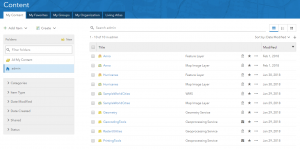Today I would like show you the new properties exposed on the feature layer. These properties are new in 10.6 for services that reference an enterprise geodatabase. If you want to see a general overview of the new feature service capabilities in 10.6, see my other post: What’s New with Feature Services in 10.6.
You might be saying to yourself: “Wait a minute – there are new layer properties in 10.6?” There certainly are, and they allow you to better understand and describe your data.
modelName
The first property I would like to talk about is modelName. Fields in a geodatabase can have up to three names: the true name, the alias name, or the model name. If developers are making custom objects, they can use modelName as a tool to guarantee the names of objects separate from the true name or alias name. Simply put, the modelName property describes the model name for the geodatabase table. It is exposed on both fields and layers, and provided by back-end geodatabase tables, feature classes, and fields.
isDataArchived
The next property is called isDataArchived. It can be true or false depending on whether your data is archived or not. If your data is archived, this property allows the feature layer to support queries with historicMoment. These two in combination allow you to view changes made to your data at a specific point in time. Querying with historicMoment is supported if your data is (1) branch versioned, (2) non-versioned with archiving enabled, or (3) traditionally versioned with archiving enabled on the default version.
To clarify the third option, it means that you need to make sure you are querying against the default version. If you publish data from a named version and don’t specify a version name when you query with a historicMoment, the named version will be used by default and will give you an error. To avoid this confusion, make sure you either publish your data from the default version or specify the default version with historicMoment when querying traditionally versioned data with archiving enabled . If you want to learn more about archiving, visit this page. If you want to know more about historical moments, visit this page.
isCoGoEnabled
Like isDataArchived, the isCoGoEnabled property can also be true or false, but instead identifies whether a layer has coordinate geometry enabled. If you’re not sure what coordinate geometry is, it’s a method for calculating locations from surveyed bearings, distances, and angles typically used in land surveying. If you want to learn more about using coordinate geometry with your data, click here.
parentLayer
With the introduction of the Utility Network in 10.6, a new layer property was exposed on the feature layer called parentLayer. The purpose of the parentLayer property is to reference the utility network layer from sublayers of the utility network layer. To explain a little further, the utility network layer itself has a series of sublayers. It is within these sublayers that the parentLayer property is designed for, to essentially identify that they are a part of the utility network parent layer. Now, what if you’re working with layers that are not sublayers of a utility network layer? In that case, the value of parentLayer is NULL.
defaultValue & description
If you assign a field in your geodatabase a default value, as of 10.6 it will now show the field with a defaultValue property, and if you have domains in your geodatabase, they now have a set property called description. Looking at your data, it might look something like this:
"fields": [
{
"name": "shortint",
"type": "esriFieldTypeInteger"
"domain": {
"type": "range",
"name": "integer",
"description": "valid numbers" | ""
}
"defaultValue": 0 | null
}
]
If you do not specify a default value, the value will be set to null. If you don’t specify a description, the property will default to an empty string value.
Something you need to keep in mind is that these properties show up only when you have data published to an ArcGIS Enterprise federated server where your data is stored in a registered enterprise geodatabase.


Article Discussion: